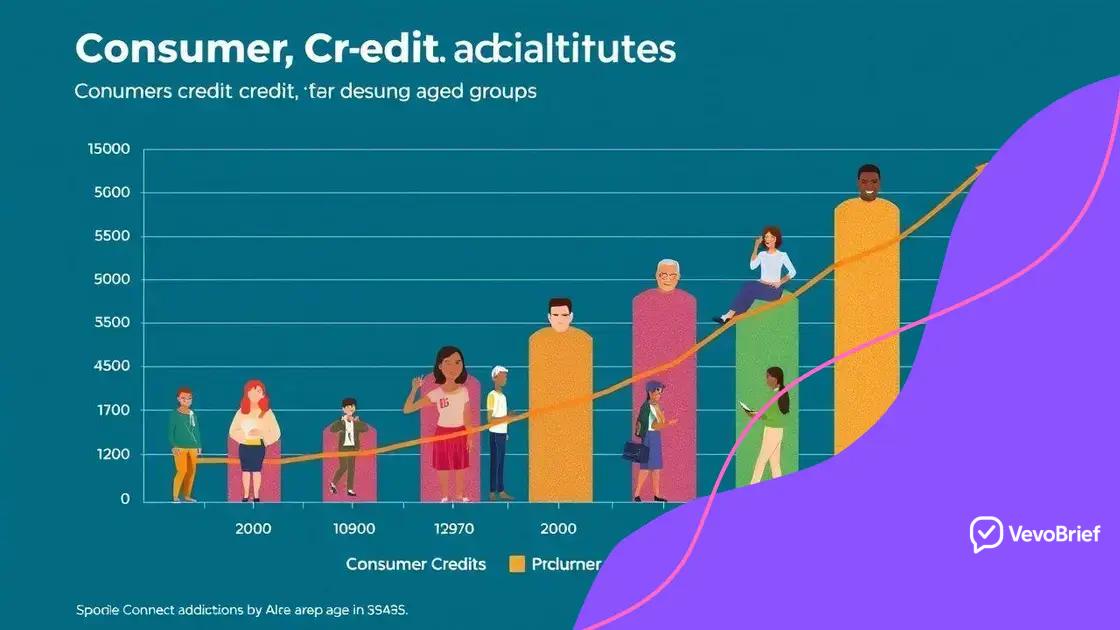Consumer credit trends by age group analyzed: what you need to know

Consumer credit trends by age group reveal that younger generations prefer digital solutions, middle-aged adults focus on debt management, and seniors are increasingly engaging with technology for better credit access.
Consumer credit trends by age group analyzed provide fascinating insights into how different generations approach borrowing. Have you ever wondered how age influences people’s spending habits? Let’s dive in!
Understanding consumer credit: an overview
Understanding consumer credit is essential in today’s financial landscape. It is a vital aspect that affects individuals of all ages. Knowing how credit works can significantly impact your financial choices and future opportunities.
What is Consumer Credit?
Consumer credit refers to the borrowing of funds to purchase goods and services, which individuals repay over time. This type of credit can include credit cards, personal loans, and mortgages. Understanding how these tools work can help consumers make informed decisions.
Key Types of Consumer Credit
- Credit Cards: Used for everyday purchases, allowing borrowers to buy now and pay later.
- Personal Loans: Unsecured loans for personal expenses like vacations or emergencies.
- Mortgages: Loans specifically for purchasing homes, often with long repayment periods.
- Auto Loans: Financing specifically for buying vehicles, usually secured by the car itself.
Each type of credit has its unique features and implications. Consumers should consider interest rates, repayment terms, and their overall financial health when choosing a credit option. Credit plays a significant role in shaping financial habits. Young adults, for instance, may be more likely to use credit cards, while older adults might lean towards loans for homes and cars.
Understanding one’s credit score is equally important. This score, which typically ranges from 300 to 850, indicates a borrower’s creditworthiness. A higher score often leads to better interest rates, ultimately saving consumers money. Monitoring and improving your credit score can have beneficial effects, especially when applying for significant loans.
As age groups vary in their approach to consumer credit, it’s essential to analyze how these trends shift over time. Factors such as economic conditions, technology, and lifestyle influences play substantial roles in shaping borrowing behaviors. Engaging with these trends can empower consumers to make smarter financial decisions.
Trends in credit usage by young adults
Trends in credit usage by young adults reveal interesting patterns that can shape their financial futures. As this generation navigates the financial world, their choices reflect their unique circumstances and challenges.
Current Trends
Young adults are increasingly turning to credit cards for everyday purchases. This trend shows how important accessibility and convenience are for younger consumers. Many often prioritize lifestyle purchases, from dining out to travel, which can lead to higher credit card balances.
Factors Influencing Credit Choices
- Technology: The rise of digital banking has made applying for credit easier than ever.
- Social Media: Influences from social platforms can affect spending behaviors and trends.
- Student Loans: Many young adults carry student debt, which impacts their credit utilization.
- Financial Education: Awareness of credit scores and responsible borrowing is growing.
As young adults embrace credit, they also face the responsibility of managing it wisely. Financial literacy plays a crucial role in how they engage with credit products. Many are learning to monitor their credit scores and understand the long-term impacts of their financial decisions.
Despite facing challenges, such as high student debt and the rising cost of living, young adults are finding ways to use credit responsibly. This generation is often more aware of the importance of budgeting and saving, which can help them make informed choices.
These trends highlight the adaptability of young adults in a rapidly changing economic landscape. Understanding their credit behavior is essential for financial institutions and lenders to meet their needs effectively.
Middle-aged borrowers: habits and challenges

Middle-aged borrowers face unique habits and challenges when it comes to credit. This group, typically ranging from ages 40 to 60, often holds significant financial responsibilities, including mortgages, education for children, and preparing for retirement.
Common Habits of Middle-aged Borrowers
Many in this age bracket tend to have established credit histories. They often use credit cards for everyday purchases but may also rely on personal loans for larger expenses. This generation often prioritizes stability and tends to avoid high-risk financial behaviors.
Challenges Faced
- Debt Management: Many middle-aged borrowers struggle with managing multiple debts, including mortgages and personal loans.
- Job Instability: Economic downturns can lead to fears of job loss, making it crucial for borrowers to maintain good credit.
- Health Costs: As they age, unforeseen medical expenses can arise, affecting their financial situation.
- Retirement Planning: Many are caught between saving for retirement and managing current expenses.
These challenges can significantly affect their ability to borrow additional funds. Many middle-aged individuals are focused on paying down existing debts while ensuring they can meet their ongoing financial obligations. Understanding their credit scores becomes essential as they work towards financial stability.
When it comes to borrowing, middle-aged adults often prefer fixed-rate loans for predictable payments. This helps them manage their budgets more effectively. Additionally, financial literacy programs can greatly benefit this demographic, empowering them to make informed decisions about their borrowing habits.
The elderly and credit: a changing landscape
The elderly and credit represent a changing landscape in financial behavior and access. As the aging population grows, their approach to credit is evolving to meet their unique needs and circumstances.
Changing Credit Habits
Historically, many elderly individuals preferred to avoid credit. However, more seniors are now using credit cards and loans for convenience and managing expenses. This shift indicates a growing comfort with credit products among older adults.
Factors Driving Change
- Healthcare Expenses: Rising medical costs often necessitate the use of credit to cover unexpected bills.
- Technological Advances: Many seniors have become more tech-savvy, making online applications and management of credit easier.
- Financial Education: More resources are available to help older adults understand credit and how to use it responsibly.
- Cultural Shifts: Changing societal views on debt have encouraged seniors to engage with credit more actively.
As credit usage increases, understanding how it impacts financial security becomes crucial for elderly consumers. Many are now focusing on building or maintaining their credit scores to secure better interest rates for loans.
Another trend is the rise of senior-focused financial products. Lenders are developing loans specifically designed for older adults, offering favorable terms and lower fees. This offers seniors more options to meet their financial needs.
Despite the positive trends, challenges remain. Many elderly borrowers still face discrimination and higher interest rates based on age. Advocating for fair lending practices is essential to ensure that seniors have equal access to credit opportunities.
Future predictions for credit trends by age
Future predictions for credit trends by age suggest exciting changes in how different generations will manage borrowing. As technology and social norms evolve, so will the ways people interact with credit.
Trends for Younger Generations
Younger consumers, such as millennials and Gen Z, are projected to continue favoring digital solutions. This demographic is likely to embrace mobile banking, online lending, and financial apps that simplify credit management. As they gain financial literacy, they will become more strategic in using credit.
Shift in Borrowing Preferences
- Personalization: Lenders are expected to offer more tailored credit products that fit individual financial situations.
- Flexible Payments: Future credit products are likely to include flexible repayment options that cater to varying income levels.
- Emphasis on Sustainability: Younger borrowers may prioritize loans that support sustainable practices and ethical lending.
- Increased Use of AI: Artificial intelligence will likely play a role in assessing creditworthiness, leading to faster decisions.
As for middle-aged borrowers, the focus may shift towards using credit more responsibly while managing existing debts. This generation will likely incorporate financial education to navigate challenges, such as healthcare costs and retirement planning. Their approach will emphasize stability and long-term financial health.
Regarding seniors, predictions indicate a rise in credit accessibility for older adults. As they become more comfortable with technology, more seniors may engage with online credit management tools. Financial institutions are expected to develop products that address their unique needs, providing more options for loans and credit cards.
The overall landscape of credit is transforming, driven by demographic shifts, technological innovation, and changing consumer expectations. Adapting to these trends will be essential for lenders and consumers alike.
Conclusion
In summary, understanding consumer credit trends by age group is vital for making informed financial decisions. As we look to the future, younger generations are expected to embrace digital solutions, while middle-aged adults will focus on managing their debts responsibly. Seniors will increasingly engage with technology, allowing for better access to credit options. With these shifts, lenders must adapt to meet the evolving needs of each age group.
By recognizing these trends and challenges, consumers can navigate their financial journeys with confidence. It is essential to stay informed and responsible in using credit to build a secure financial future.
FAQ – Consumer Credit Trends by Age
What are the credit habits of younger generations?
Younger generations are increasingly using digital solutions for credit management, such as apps for budgeting and online lending platforms.
How do middle-aged borrowers manage their credit?
Middle-aged borrowers focus on managing existing debts while prioritizing financial stability and making informed decisions about new credit.
What challenges do elderly borrowers face?
Elderly borrowers may encounter difficulties such as healthcare costs and age-related biases in credit accessibility but are increasingly using technology for better credit management.
How are lenders adapting to changing credit trends?
Lenders are developing tailored products that meet the specific needs of different age groups, enhancing accessibility and promoting responsible borrowing.
